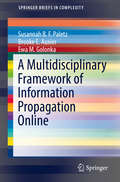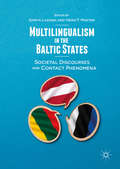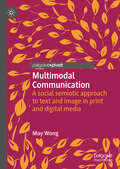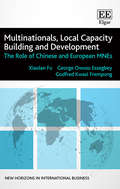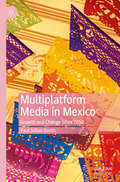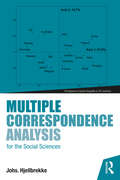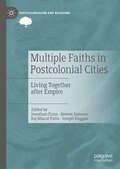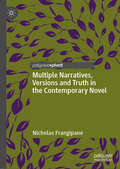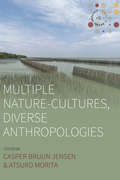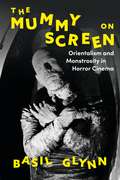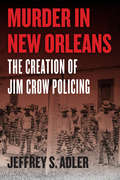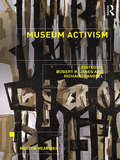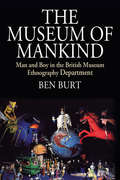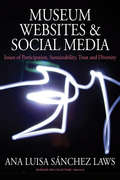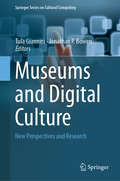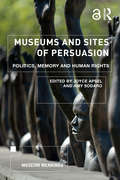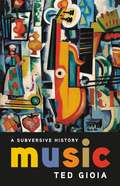- Table View
- List View
A Multidisciplinary Framework of Information Propagation Online (SpringerBriefs in Complexity)
by Susannah B. Paletz Brooke E. Auxier Ewa M. GolonkaThis book presents a broad, multidisciplinary review of the factors that have been shown to or might influence sharing information on social media, regardless of its veracity. Drawing on literature from psychology, sociology, political science, communication, and information studies, the book provides a high-level framework of information sharing. The framework progresses through different categories. Information is first acquired or viewed from different sources; then, the target sharer has emotional and cognitive reactions to that information. The next categories involve motivations to share and the actual ability and perceptions of that ability to share. The greater context, such as culture, language, and social networks, also influences information sharing. Finally, the book distinguishes between genuine and non-genuine (inauthentic) actors. This text will appeal to students and especially to technical researchers looking for a social science perspective.
Multikulturalismus im Diskurs: Deutsche und europäische Identitätskonstruktionen im Hinblick auf die Zugehörigkeit muslimischer Migranten (Kultur und soziale Praxis)
by Thea D. BoldtDie deutsche Identitätspolitik hat durch die Auseinandersetzung mit muslimischen Migranten eine neue Wendung erlangt. Thea D. Boldt analysiert diesen Übergang im Zeitraum von 2000 bis 2011 mit besonderem Fokus auf das Konzept des Multikulturalismus. Dabei zeichnet sie die Transformation Deutschlands von einer Nation des ius sanguinis zu einer multikulturellen Gesellschaft in einem diskursiven Spannungsfeld zwischen staatlichen und nicht-staatlichen Akteuren - darunter Vertreter muslimischer Verbände - nach. Vor diesem Hintergrund erscheint die deutsche Debatte um den »Multikulti«-Begriff als Vorreiter einer neuen europäischen Identität und einer neuen europäischen Migrationsagenda.
Multilingualism in the Baltic States: Societal Discourses and Contact Phenomena
by Sanita Lazdiņa Heiko F. MartenThis edited collection provides an overview of linguistic diversity, societal discourses and interaction between majorities and minorities in the Baltic States. It presents a wide range of methods and research paradigms including folk linguistics, discourse analysis, narrative analyses, code alternation, ethnographic observations, language learning motivation, languages in education and language acquisition. Grouped thematically, its chapters examine regional varieties and minority languages (Latgalian, Võro, urban dialects in Lithuania, Polish in Lithuania); the integration of the Russian language and its speakers; and the role of international languages like English in Baltic societies. The editors’ introductory and concluding chapters provide a comparative perspective that situates these issues within the particular history of the region and broader debates on language and nationalism at a time of both increased globalization and ethno-regionalism. This book will appeal in particular to students and scholars of multilingualism, sociolinguistics, language discourses and language policy, and provide a valuable resource for researchers focusing on Baltic States, Northern Europe and the post-Soviet world in the related fields of history, political science, sociology and anthropology.
Multimodal Communication: A social semiotic approach to text and image in print and digital media
by May WongThis book draws on visual data, ranging from advertisements to postage stamps to digital personal photography, to offer a complex interpretation of the different social functions realised by these texts as semiotic artefacts. Framed within the media environment of the city of Hong Kong, the study demonstrates the importance of social context to meaning making and social semiotic multimodal analysis. This book will be of interest to readers in the arts, humanities and social sciences, particularly within the fields of semiotics, visual studies, design studies, media and cultural studies, anthropology and sociology.
Multinationals, Local Capacity Building and Development: The Role of Chinese and European MNEs (New Horizons in International Business series)
by Xiaolan Fu Owusu Essegbey Godfred K. FrempongMultinational enterprises (MNEs) are everywhere and the perception of their engagement in myriad activities ranges between extremely positive and extremely negative. Based on original comprehensive research, this groundbreaking book examines the impact of Chinese and European MNEs in the African context. Sharing knowledge and insights from the authors’ empirical research, Multinationals, Local Capacity Building and Development uses Ghana as a case study to analyse trends in MNEs and assess the advantages and disadvantages of their involvement. The book examines the role of MNEs in Ghana’s industrial sector, their management practices and the effects of skill transfer from foreign managers to local workers. The authors explore the impact MNEs are having on the development of local capabilities, the contribution of MNEs to sustainable development goals, and the benefits and drawbacks of foreign direct investment in Ghana. The roles of work and social networks, and the differences between European and Chinese MNEs, all subjects previously unaddressed in the field are exposed in depth. The insights presented in this book will be of significant interest to policy makers, both public and private sector development practitioners, and students of development, as well as any readers concerned with addressing better engagement with key economic actors on the African continent.
Multiplatform Media in Mexico: Growth and Change Since 2010
by Paul Julian SmithMultiplatform Media in Mexico is the first book to treat the exciting, interconnected fields of cinema, television, and internet in Mexico over the last decade, fields that combine to be called multiplatform media. Combining industrial analysis of a major audiovisual field at a time of growth and change with close readings of significant texts on all screens, acclaimed author Paul Julian Smith deftly details these new audiovisual trends. The book includes perspectives on local reporting on the ground, as covered in the chapter documenting media response to the 2017 earthquake. And, for the first time in this field, the book draws throughout on star studies, tracing the distinct profiles of actors who migrate from one medium to another. As a whole, Smith’s analyses illustrate the key movements in screen media in one of the world’s largest media and cultural producing nations. These perspectives connect to and enrich scholarship across Latin American, North American, and global cases.
Multiple Correspondence Analysis for the Social Sciences
by Johs. HjellbrekkeMultiple correspondence analysis (MCA) is a statistical technique that first and foremost has become known through the work of the late Pierre Bourdieu (1930–2002). This book will introduce readers to the fundamental properties, procedures and rules of interpretation of the most commonly used forms of correspondence analysis. The book is written as a non-technical introduction, intended for the advanced undergraduate level and onwards. MCA represents and models data sets as clouds of points in a multidimensional Euclidean space. The interpretation of the data is based on these clouds of points. In seven chapters, this non-technical book will provide the reader with a comprehensive introduction and the needed knowledge to do analyses on his/her own: CA, MCA, specific MCA, the integration of MCA and variance analysis, of MCA and ascending hierarchical cluster analysis and class-specific MCA on subgroups. Special attention will be given to the construction of social spaces, to the construction of typologies and to group internal oppositions. This is a book on data analysis for the social sciences rather than a book on statistics. The main emphasis is on how to apply MCA to the analysis of practical research questions. It does not require a solid understanding of statistics and/or mathematics, and provides the reader with the needed knowledge to do analyses on his/her own.
Multiple Correspondence Analysis for the Social Sciences
by Johs. HjellbrekkeMultiple correspondence analysis (MCA) is a statistical technique that first and foremost has become known through the work of the late Pierre Bourdieu (1930–2002). This book will introduce readers to the fundamental properties, procedures and rules of interpretation of the most commonly used forms of correspondence analysis. The book is written as a non-technical introduction, intended for the advanced undergraduate level and onwards. MCA represents and models data sets as clouds of points in a multidimensional Euclidean space. The interpretation of the data is based on these clouds of points. In seven chapters, this non-technical book will provide the reader with a comprehensive introduction and the needed knowledge to do analyses on his/her own: CA, MCA, specific MCA, the integration of MCA and variance analysis, of MCA and ascending hierarchical cluster analysis and class-specific MCA on subgroups. Special attention will be given to the construction of social spaces, to the construction of typologies and to group internal oppositions. This is a book on data analysis for the social sciences rather than a book on statistics. The main emphasis is on how to apply MCA to the analysis of practical research questions. It does not require a solid understanding of statistics and/or mathematics, and provides the reader with the needed knowledge to do analyses on his/her own.
Multiple Faiths in Postcolonial Cities: Living Together after Empire (Postcolonialism and Religions)
by Jonathan Dunn Heleen Joziasse Raj Bharat Patta Joseph DugganThis book addresses the challenges of living together after empire in many post-colonial cities. It is organized in two sections. The first section focuses on efforts by people of multiple faiths to live together within their contexts, including such efforts within a neighborhood in urban Manchester; the array of attempts at creating multi-faith spaces for worship across the globe; and initiatives to commemorate divisive conflict together in Northern Ireland. The second section utilizes particular postcolonial methods to illuminate pressing issues within specific contexts—including women’s leadership in an indigenous denomination in the variegated African landscape, and baptism and discipleship among Dalit communities in India. In the context of growing multiculturalism in the West, this volume offers a postcolonial theological resource, challenging the epistemologies in the Western academy.
Multiple Narratives, Versions and Truth in the Contemporary Novel
by Nicholas FrangipaneMultiple Narratives, Versions and Truth in the Contemporary Novel considers the shifting perception of truth in fiction. Nicholas Frangipane examines the narrative technique of telling multiple versions of the same sets of events, presenting both true and false versions of the events within a fictional work. This book looks closely at these “Reflexive Double Narratives” in order to understand the way many contemporary writers have attempted to work past postmodernism without forgetting its lessons. Frangipane explores how writers like Ian McEwan, Yann Martel and Alice Munro have departed from the radical experimentation of their predecessors and instead make sincere attempts to find ways that fictional writing can reveal enduring truths, and in so doing, redefine the meaning of “truth” itself and signal the emergence of post-postmodernism.
Multiple Nature-Cultures, Diverse Anthropologies (Studies in Social Analysis #9)
by Casper Bruun Jensen Atsuro MoritaOver time, the role of nature in anthropology has evolved from being a mere backdrop for social and cultural diversity to being viewed as an integral part of the ontological entanglement of human and nonhuman agents. This transformation of the role of nature offers important insight into the relationships between diverse anthropological traditions. By highlighting natural-cultural worlds alongside these traditions, Multiple Nature-Cultures, Diverse Anthropologies explores the potential for creating more sophisticated conjunctions of anthropological knowledge and practice.
The Mummy on Screen: Orientalism and Monstrosity in Horror Cinema (International Library Of The Moving Image Ser.)
by Basil GlynnThe Mummy is one of the most recognizable figures in horror and is as established in the popular imagination as virtually any other monster, yet the Mummy on screen has until now remained a largely overlooked figure in critical analysis of the cinema. In this compelling new study, Basil Glynn explores the history of the Mummy film, uncovering lost and half-forgotten movies along the way, revealing the cinematic Mummy to be an astonishingly diverse and protean figure with a myriad of on-screen incarnations. In the course of investigating the enduring appeal of this most 'Oriental' of monsters, Glynn traces the Mummy's development on screen from its roots in popular culture and silent cinema, through Universal Studios' Mummy movies of the 1930s and 40s, to Hammer Horror's re-imagining of the figure in the 1950s, and beyond.
Murder in New Orleans: The Creation of Jim Crow Policing (Historical Studies of Urban America)
by Jeffrey S. AdlerNew Orleans in the 1920s and 1930s was a deadly place. In 1925, the city’s homicide rate was six times that of New York City and twelve times that of Boston. Jeffrey S. Adler has explored every homicide recorded in New Orleans between 1925 and 1940—over two thousand in all—scouring police and autopsy reports, old interviews, and crumbling newspapers. More than simply quantifying these cases, Adler places them in larger contexts—legal, political, cultural, and demographic—and emerges with a tale of racism, urban violence, and vicious policing that has startling relevance for today. Murder in New Orleans shows that whites were convicted of homicide at far higher rates than blacks leading up to the mid-1920s. But by the end of the following decade, this pattern had reversed completely, despite an overall drop in municipal crime rates. The injustice of this sharp rise in arrests was compounded by increasingly brutal treatment of black subjects by the New Orleans police department. Adler explores other counterintuitive trends in violence, particularly how murder soared during the flush times of the Roaring Twenties, how it plummeted during the Great Depression, and how the vicious response to African American crime occurred even as such violence plunged in frequency—revealing that the city’s cycle of racial policing and punishment was connected less to actual patterns of wrongdoing than to the national enshrinement of Jim Crow. Rather than some hyperviolent outlier, this Louisiana city was a harbinger of the endemic racism at the center of today’s criminal justice state. Murder in New Orleans lays bare how decades-old crimes, and the racially motivated cruelty of the official response, have baleful resonance in the age of Black Lives Matter.
Murder in New Orleans: The Creation of Jim Crow Policing (Historical Studies of Urban America)
by Jeffrey S. AdlerNew Orleans in the 1920s and 1930s was a deadly place. In 1925, the city’s homicide rate was six times that of New York City and twelve times that of Boston. Jeffrey S. Adler has explored every homicide recorded in New Orleans between 1925 and 1940—over two thousand in all—scouring police and autopsy reports, old interviews, and crumbling newspapers. More than simply quantifying these cases, Adler places them in larger contexts—legal, political, cultural, and demographic—and emerges with a tale of racism, urban violence, and vicious policing that has startling relevance for today. Murder in New Orleans shows that whites were convicted of homicide at far higher rates than blacks leading up to the mid-1920s. But by the end of the following decade, this pattern had reversed completely, despite an overall drop in municipal crime rates. The injustice of this sharp rise in arrests was compounded by increasingly brutal treatment of black subjects by the New Orleans police department. Adler explores other counterintuitive trends in violence, particularly how murder soared during the flush times of the Roaring Twenties, how it plummeted during the Great Depression, and how the vicious response to African American crime occurred even as such violence plunged in frequency—revealing that the city’s cycle of racial policing and punishment was connected less to actual patterns of wrongdoing than to the national enshrinement of Jim Crow. Rather than some hyperviolent outlier, this Louisiana city was a harbinger of the endemic racism at the center of today’s criminal justice state. Murder in New Orleans lays bare how decades-old crimes, and the racially motivated cruelty of the official response, have baleful resonance in the age of Black Lives Matter.
Murder in New Orleans: The Creation of Jim Crow Policing (Historical Studies of Urban America)
by Jeffrey S. AdlerNew Orleans in the 1920s and 1930s was a deadly place. In 1925, the city’s homicide rate was six times that of New York City and twelve times that of Boston. Jeffrey S. Adler has explored every homicide recorded in New Orleans between 1925 and 1940—over two thousand in all—scouring police and autopsy reports, old interviews, and crumbling newspapers. More than simply quantifying these cases, Adler places them in larger contexts—legal, political, cultural, and demographic—and emerges with a tale of racism, urban violence, and vicious policing that has startling relevance for today. Murder in New Orleans shows that whites were convicted of homicide at far higher rates than blacks leading up to the mid-1920s. But by the end of the following decade, this pattern had reversed completely, despite an overall drop in municipal crime rates. The injustice of this sharp rise in arrests was compounded by increasingly brutal treatment of black subjects by the New Orleans police department. Adler explores other counterintuitive trends in violence, particularly how murder soared during the flush times of the Roaring Twenties, how it plummeted during the Great Depression, and how the vicious response to African American crime occurred even as such violence plunged in frequency—revealing that the city’s cycle of racial policing and punishment was connected less to actual patterns of wrongdoing than to the national enshrinement of Jim Crow. Rather than some hyperviolent outlier, this Louisiana city was a harbinger of the endemic racism at the center of today’s criminal justice state. Murder in New Orleans lays bare how decades-old crimes, and the racially motivated cruelty of the official response, have baleful resonance in the age of Black Lives Matter.
Murder in New Orleans: The Creation of Jim Crow Policing (Historical Studies of Urban America)
by Jeffrey S. AdlerNew Orleans in the 1920s and 1930s was a deadly place. In 1925, the city’s homicide rate was six times that of New York City and twelve times that of Boston. Jeffrey S. Adler has explored every homicide recorded in New Orleans between 1925 and 1940—over two thousand in all—scouring police and autopsy reports, old interviews, and crumbling newspapers. More than simply quantifying these cases, Adler places them in larger contexts—legal, political, cultural, and demographic—and emerges with a tale of racism, urban violence, and vicious policing that has startling relevance for today. Murder in New Orleans shows that whites were convicted of homicide at far higher rates than blacks leading up to the mid-1920s. But by the end of the following decade, this pattern had reversed completely, despite an overall drop in municipal crime rates. The injustice of this sharp rise in arrests was compounded by increasingly brutal treatment of black subjects by the New Orleans police department. Adler explores other counterintuitive trends in violence, particularly how murder soared during the flush times of the Roaring Twenties, how it plummeted during the Great Depression, and how the vicious response to African American crime occurred even as such violence plunged in frequency—revealing that the city’s cycle of racial policing and punishment was connected less to actual patterns of wrongdoing than to the national enshrinement of Jim Crow. Rather than some hyperviolent outlier, this Louisiana city was a harbinger of the endemic racism at the center of today’s criminal justice state. Murder in New Orleans lays bare how decades-old crimes, and the racially motivated cruelty of the official response, have baleful resonance in the age of Black Lives Matter.
Museum Activism (Museum Meanings)
by Robert R. Janes Richard SandellOnly a decade ago, the notion that museums, galleries and heritage organisations might engage in activist practice, with explicit intent to act upon inequalities, injustices and environmental crises, was met with scepticism and often derision. Seeking to purposefully bring about social change was viewed by many within and beyond the museum community as inappropriately political and antithetical to fundamental professional values. Today, although the idea remains controversial, the way we think about the roles and responsibilities of museums as knowledge based, social institutions is changing. Museum Activism examines the increasing significance of this activist trend in thinking and practice. At this crucial time in the evolution of museum thinking and practice, this ground-breaking volume brings together more than fifty contributors working across six continents to explore, analyse and critically reflect upon the museum’s relationship to activism. Including contributions from practitioners, artists, activists and researchers, this wide-ranging examination of new and divergent expressions of the inherent power of museums as forces for good, and as activists in civil society, aims to encourage further experimentation and enrich the debate in this nascent and uncertain field of museum practice. Museum Activism elucidates the largely untapped potential for museums as key intellectual and civic resources to address inequalities, injustice and environmental challenges. This makes the book essential reading for scholars and students of museum and heritage studies, gallery studies, arts and heritage management, and politics. It will be a source of inspiration to museum practitioners and museum leaders around the globe.
Museum Activism: Activism And Agency In The Museum (Museum Meanings)
by Robert R. Janes Richard SandellOnly a decade ago, the notion that museums, galleries and heritage organisations might engage in activist practice, with explicit intent to act upon inequalities, injustices and environmental crises, was met with scepticism and often derision. Seeking to purposefully bring about social change was viewed by many within and beyond the museum community as inappropriately political and antithetical to fundamental professional values. Today, although the idea remains controversial, the way we think about the roles and responsibilities of museums as knowledge based, social institutions is changing. Museum Activism examines the increasing significance of this activist trend in thinking and practice. At this crucial time in the evolution of museum thinking and practice, this ground-breaking volume brings together more than fifty contributors working across six continents to explore, analyse and critically reflect upon the museum’s relationship to activism. Including contributions from practitioners, artists, activists and researchers, this wide-ranging examination of new and divergent expressions of the inherent power of museums as forces for good, and as activists in civil society, aims to encourage further experimentation and enrich the debate in this nascent and uncertain field of museum practice. Museum Activism elucidates the largely untapped potential for museums as key intellectual and civic resources to address inequalities, injustice and environmental challenges. This makes the book essential reading for scholars and students of museum and heritage studies, gallery studies, arts and heritage management, and politics. It will be a source of inspiration to museum practitioners and museum leaders around the globe.
The Museum of Mankind: Man and Boy in the British Museum Ethnography Department (Museums and Collections #12)
by Ben BurtThe Museum of Mankind was an innovative and popular showcase for minority cultures from around the non-Western world from 1970 to 1997. This memoir is a critical appreciation of its achievements in the various roles of a national museum, of the personalities of its staff and of the issues raised in the representation of exotic cultures. Issues of changing museum theory and practice are raised in a detailed case-study that also focuses on the social life of the museum community. This is the first history of a remarkable museum and a memorable interlude in the long history of one of the world’s oldest and greatest museums. Although not presented as an academic study, it should be useful for museum and cultural studies as a well as a wider readership interested in the British Museum.
Museum Websites and Social Media: Issues of Participation, Sustainability, Trust and Diversity (Museums and Collections #8)
by Ana Sánchez LawsOnline activities present a unique challenge for museums as they harness the potential of digital technology for sustainable development, trust building, and representations of diversity. This volume offers a holistic picture of museum online activities that can serve as a starting point for cross-disciplinary discussion. It is a resource for museum staff, students, designers, and researchers working at the intersection of cultural institutions and digital technologies. The aim is to provide insight into the issues behind designing and implementing web pages and social media to serve the broadest range of museum stakeholders.
Museums and Digital Culture: New Perspectives and Research (Springer Series on Cultural Computing)
by Jonathan P. Bowen Tula GianniniThis book explores how digital culture is transforming museums in the 21st century. Offering a corpus of new evidence for readers to explore, the authors trace the digital evolution of the museum and that of their audiences, now fully immersed in digital life, from the Internet to home and work. In a world where life in code and digits has redefined human information behavior and dominates daily activity and communication, ubiquitous use of digital tools and technology is radically changing the social contexts and purposes of museum exhibitions and collections, the work of museum professionals and the expectations of visitors, real and virtual. Moving beyond their walls, with local and global communities, museums are evolving into highly dynamic, socially aware and relevant institutions as their connections to the global digital ecosystem are strengthened. As they adopt a visitor-centered model and design visitor experiences, their priorities shift to engage audiences, convey digital collections, and tell stories through exhibitions. This is all part of crafting a dynamic and innovative museum identity of the future, made whole by seamless integration with digital culture, digital thinking, aesthetics, seeing and hearing, where visitors are welcomed participants. The international and interdisciplinary chapter contributors include digital artists, academics, and museum professionals. In themed parts the chapters present varied evidence-based research and case studies on museum theory, philosophy, collections, exhibitions, libraries, digital art and digital future, to bring new insights and perspectives, designed to inspire readers. Enjoy the journey!
Museums and Sites of Persuasion: Politics, Memory and Human Rights (Museum Meanings)
by Joyce Apsel Amy SodaroMuseums and Sites of Persuasion examines the concept of museums and memory sites as locations that attempt to promote human rights, democracy and peace. Demonstrating that such sites have the potential to act as powerful spaces of persuasion or contestation, the book also shows that there are perils in the selective memory and history that they present. Examining a range of museums, memorials and exhibits in places as varied as Burundi, Denmark, Georgia, Kosovo, Mexico, Peru, Vietnam and the US, this volume demonstrates how they represent and try to come to terms with difficult histories. As sites of persuasion, the contributors to this book argue, their public goal is to use memory and education about the past to provide moral lessons to visitors that will encourage a more democratic and peaceful future. However, the case studies also demonstrate how political, economic and social realities often undermine this lofty goal, raising questions about how these sites of persuasion actually function on a daily basis. Straddling several interdisciplinary fields of research and study, Museums and Sites of Persuasion will be essential reading for those working in the fields of museum studies, memory studies, and genocide studies. It will also be essential reading for museum practitioners and anyone engaged in the study of history, sociology, political science, anthropology and art history.
Museums and Sites of Persuasion: Politics, Memory and Human Rights (Museum Meanings)
by Joyce Apsel Amy SodaroMuseums and Sites of Persuasion examines the concept of museums and memory sites as locations that attempt to promote human rights, democracy and peace. Demonstrating that such sites have the potential to act as powerful spaces of persuasion or contestation, the book also shows that there are perils in the selective memory and history that they present. Examining a range of museums, memorials and exhibits in places as varied as Burundi, Denmark, Georgia, Kosovo, Mexico, Peru, Vietnam and the US, this volume demonstrates how they represent and try to come to terms with difficult histories. As sites of persuasion, the contributors to this book argue, their public goal is to use memory and education about the past to provide moral lessons to visitors that will encourage a more democratic and peaceful future. However, the case studies also demonstrate how political, economic and social realities often undermine this lofty goal, raising questions about how these sites of persuasion actually function on a daily basis. Straddling several interdisciplinary fields of research and study, Museums and Sites of Persuasion will be essential reading for those working in the fields of museum studies, memory studies, and genocide studies. It will also be essential reading for museum practitioners and anyone engaged in the study of history, sociology, political science, anthropology and art history.
Music: A Subversive History
by Ted GioiaFrom the dawn of civilization to the modern-day music scene, this breathtaking global history reveals how songs have shifted societies and sparked revolutions.Histories of music overwhelmingly suppress stories of the outsiders and rebels who created musical revolutions and instead celebrate the mainstream assimilators who borrowed innovations, diluted their impact, and disguised their sources. In Music: A Subversive History, historian Ted Gioia reclaims the story of music for the riffraff, insurgents, and provocateurs.Gioia tells a four-thousand-year history of music as a global source of power, change, and upheaval. He shows how social outcasts have repeatedly become trailblazers of musical expression: slaves and their descendants, for instance, have repeatedly reinvented music, from ancient times all the way to the jazz, reggae, and hip-hop sounds of the current day. Music: A Subversive History is essential reading for anyone interested in the meaning of music, from Sappho to the Sex Pistols to Spotify.
Music: A Subversive History
by Ted Gioia"A dauntingly ambitious, obsessively researched" (Los Angeles Times) global history of music that reveals how songs have shifted societies and sparked revolutions.Histories of music overwhelmingly suppress stories of the outsiders and rebels who created musical revolutions and instead celebrate the mainstream assimilators who borrowed innovations, diluted their impact, and disguised their sources. In Music: A Subversive History, Ted Gioia reclaims the story of music for the riffraff, insurgents, and provocateurs.Gioia tells a four-thousand-year history of music as a global source of power, change, and upheaval. He shows how outcasts, immigrants, slaves, and others at the margins of society have repeatedly served as trailblazers of musical expression, reinventing our most cherished songs from ancient times all the way to the jazz, reggae, and hip-hop sounds of the current day.Music: A Subversive History is essential reading for anyone interested in the meaning of music, from Sappho to the Sex Pistols to Spotify.
